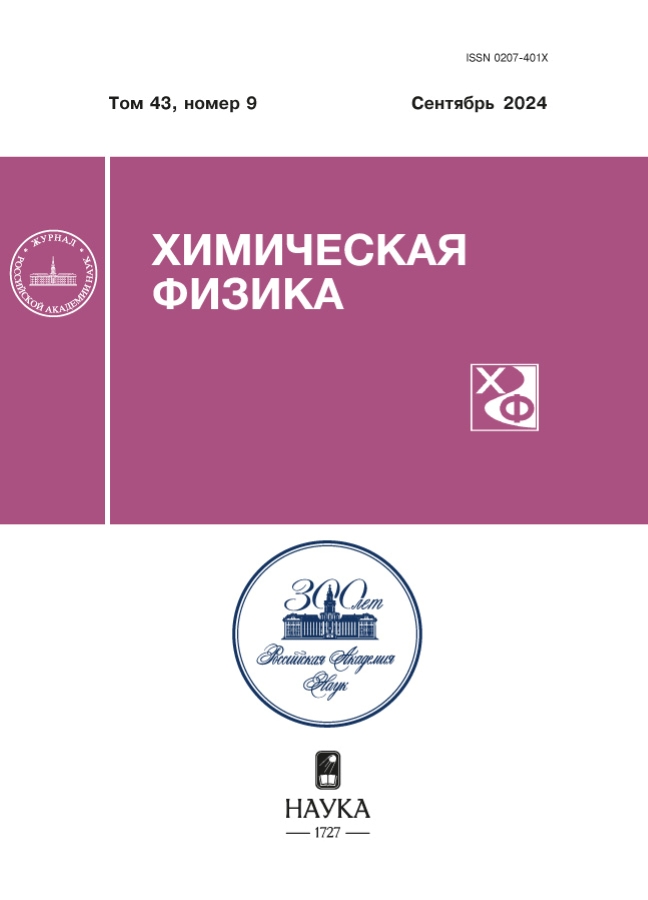Antioxidant activity of catecholamines during the oxidation of methyl linoleoate in Triton X-100 micelles
- 作者: Ryabkova V.A.1, Tikhonov I.V.1, Pliss E.M.1
-
隶属关系:
- Demidov Yaroslavl State University
- 期: 卷 43, 编号 9 (2024)
- 页面: 35-41
- 栏目: Kinetics and mechanism of chemical reactions, catalysis
- URL: https://cardiosomatics.orscience.ru/0207-401X/article/view/680964
- DOI: https://doi.org/10.31857/S0207401X24090042
- ID: 680964
如何引用文章
详细
The effect of catecholamines on the oxidation of methyl linoleate in Triton X-100 micelles was studied. It has been established that catecholamines do not inhibit oxidation at a pH 7.4. Inhibition is only possible in the presence of the superoxide dismutase enzyme or at lower pH levels. The reason for this effect is the interaction of anionic forms of phenols and phenoxyl radicals with oxygen with the formation of superoxide anions. High values of inhibition coefficients for catecholamines in the presence of superoxide dismutase are due to the reactions of the resulting ortho-quinones, leading to the regeneration of OH groups.
全文:
作者简介
V. Ryabkova
Demidov Yaroslavl State University
Email: tikhonoviv.ysu@gmail.com
俄罗斯联邦, Yaroslavl
I. Tikhonov
Demidov Yaroslavl State University
编辑信件的主要联系方式.
Email: tikhonoviv.ysu@gmail.com
俄罗斯联邦, Yaroslavl
E. Pliss
Demidov Yaroslavl State University
Email: tikhonoviv.ysu@gmail.com
俄罗斯联邦, Yaroslavl
参考
- I. Tikhonov, V. Roginsky, and E. Pliss, Int. J. Chem. Kinet. 41, 92 (2008). https://doi.org/10.1002/kin.20377
- I. Tichonov, V. Roginsky, and E. Pliss, Eur. J. Lipid Sci. Technol. 112, 887 (2010). https://doi.org/10.1002/ejlt.200900282
- V. Roginsky, Arch. Biochem. Biophys. 414, 261 (2003). https://doi.org/10.1016/S0003-9861(03)00143-7
- V. Roginsky, and E.A. Lissi, Food Chem. 92, 235 (2005). https://doi.org/10.1016/j.foodchem.2004.08.004
- K. Jodko-Piorecka, and G. Litwinienko, Free Radic. Biol. Med. 83, 1 (2015). https://doi.org/10.1016/j.freeradbiomed.2015.02.006
- D. Loshadkin, V. Roginsky, and E. Pliss, Int. J. Chem. Kinet. 34, 162 (2002). https://doi.org/10.1002/kin.10041
- V. Roginsky, and T. Barsukova, Chem. Phys. Lipids 111, 87 (2001). https://doi.org/10.1016/S0009-3084(01)00148-7
- V. Roginsky, T. Barsukova, D. Loshadkin, and E. Pliss, Chem. Phys. Lipids 125, 49 (2003). https://doi.org/10.1016/S0009-3084(03)00068-9
- V. Roginsky, Free Radic. Res. 35, 55 (2001). https://doi.org/10.1080/10715760100300591
- I.V. Moskalenko, and I.V. Tikhonov, Russ. J. Phys. Chem. B 16, 602 (2022). https://doi.org/10.1134/S1990793122040121
- V.M. Costa, R. Silva, L.M. Ferreira, P.S. Branco, F. Carvalho, M.L. Bastos, R.A. Carvalho, M. Carvalho, and F. Remiao, Chem. Res. Toxicol. 20, 1183 (2007). https://doi.org/10.1021/tx7000916
- T.V. Sirota, Biophysics. 65, 548 (2020). https://doi.org/10.1134/S0006350920040223
- N.A. Mautjana, J. Estes, J.R. Eyler, and A. Brajter-Toth, Electroanalysis 20, 1959 (2008). https://doi.org/10.1002/elan.200804279
- I. Iftikhar, K. Abou El-Nour, and A. Brajter-Toth, Electrochim. Acta 249, 145 (2017). https://doi.org/10.1016/j.electacta.2017.07.087
- I.F. Rusina, T.L. Veprintsev, and R.F. Vasil’ev, Russ. J. Phys. Chem. B 16, 50 (2022). https://doi.org/10.1134/S1990793122010274
- F. Mack, and H. Bonisch, Naunyn-Schmiedeberg’s Arch. Pharmacol. 310, 1 (1979). https://doi.org/10.1007/BF00499868
- N.Yu. Gerasimov, O.V. Nevrova, I.V. Zhigacheva, I.P. Generozova, and A.N. Goloshchapov, Russ. J. Phys. Chem. B 17, 135 (2023). https://doi.org/10.1134/S1990793123010049
- L.N. Shishkina, M.V. Kozlov, T.V. Konstantinova, A.N. Smirnova, and V.O. Shvydkiy, Russ. J. Phys. Chem. B 17, 141 (2023). https://doi.org/10.1134/S1990793123010104
- K. Jodko-Piorecka, B. Sikora, M. Kluzek, P. Przybylski, and G. Litwinienko, J. Org. Chem. 87, 1791 (2022). https://doi.org/10.1021/acs.joc.1c02308
补充文件













